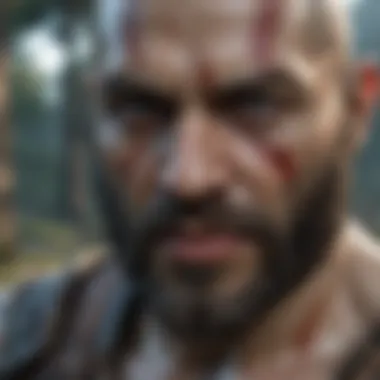Analyzing the Pricing Trends of God of War on PS4


Intro
The gaming landscape is vast and dynamic, characterized by ever-changing prices and purchasing options. God of War, particularly on the PlayStation 4, stands out as a prominent title that deserves attention not only for its narrative richness but also for its pricing journey. Understanding the price of this game encompasses more than just numbers; it provides insight into consumer behavior, market dynamics, and future trends.
In this article, we will deconstruct the pricing landscape of God of War. We will highlight the various factors that influence its pricing, such as market demand, product availability, and the rise of digital distribution. Additionally, we will compare different purchasing avenues where gamers may find this title—both in physical and digital formats.
Furthermore, we will discuss how price fluctuations affect consumers, including sales strategies employed by retailers and the implications these fluctuations have for future purchases and investments. Overall, this comprehensive analysis aims to equip gamers with the knowledge they need to navigate the pricing maze of God of War effectively.
Overview of God of War
Released in April 2018, God of War marks a significant evolution in both gameplay and narrative approach within the franchise. The game follows Kratos, a fierce Spartan warrior, now living in the realms of Norse mythology alongside his son, Atreus. The journey intertwines themes of fatherhood, redemption, and conflict, captivating players with its emotional depth.
Set against a backdrop of stunning visuals, players traverse a beautifully crafted world, plagued with mythical creatures and challenging puzzles. The gameplay combines intense combat mechanics with a richly woven narrative, making God of War not just a game but a profound experience.
Factors Influencing Price Changes
Several elements contribute to the pricing fluctuations of God of War on PS4.
- Market Demand: Popularity plays a vital role. When a game garners considerable attention, its price may see an increase due to heightened demand.
- Availability: Limited editions or bundled offers can temporarily inflate prices. As supply diminishes, prices tend to rise.
- Digital Sales: Digital platforms such as PlayStation Store usually offer promotions during seasonal sales. These promotions can significantly lower prices, affecting overall market trends.
- Retail Strategies: Retailers may methodically adjust prices based on competition and inventory levels.
Understanding these factors can help consumers make informed purchasing decisions.
Where to Buy
When considering purchasing God of War, there are multiple avenues to explore:
- Physical Retailers: Stores like GameStop or Best Buy often have used copies available for a lower price.
- Digital Platforms: The PlayStation Store may have exclusive discounts or bundles during sales events.
- Online Marketplaces: Websites like Amazon or eBay provide both new and used copies, often at competitive prices.
Price Comparison
Comparing prices from different sources can lead to significant savings. It is advisable to monitor prices across platforms. Some tools and websites track pricing history to see when the game was cheapest.
"Understanding the time when prices fluctuate can lead to making better purchasing decisions."
Future Price Trends
As we look ahead, some trends may impact the pricing of God of War. The ongoing popularity of the franchise may maintain its relevance in the market. Additionally, as new consoles are released, older titles might experience a decrease in price. However, collectibles and special editions can often retain or even grow in value over time.
Foreword to God of War on PS4
The dynamic world of video games serves as both an entertainment medium and a complex marketplace. Understanding the pricing strategy of notable titles like God of War on the PlayStation 4 is crucial for consumers and industry observers alike. This section aims to provide a foundational understanding of how this significant game fits into the broader landscape of its pricing, reflecting market trends and consumer behavior.
Overview of the Game
God of War is an action-adventure game developed by Santa Monica Studio. It launched in April 2018 and quickly gained recognition for its innovative gameplay, rich storytelling, and stunning graphics. Players navigate the adventures of Kratos, a former Greek god, alongside his son Atreus in a deeply immersive Norse mythology setting.
The gameplay integrates combat, puzzle-solving, and exploration, creating a multifaceted experience. The bond between Kratos and Atreus adds emotional depth, enhancing the narrative significantly. Receiving numerous accolades, the title set a new benchmark for storytelling in video gaming.
Initial Release and Reception


Upon its release, God of War was met with widespread critical acclaim. Reviewers lauded its engaging narrative, visual artistry, and refined combat mechanics. The game holds a remarkable rating on Metacritic, signifying strong approval from both critics and players. Sales figures reflected this success, as the game sold over five million copies within its first month, establishing itself as one of the top-selling PlayStation 4 titles.
This initial reception had a downstream effect on its pricing strategy. As the game garnered attention, prices remained stable initially but fluctuated later based on market demand. Such a trajectory is important for potential buyers to consider when analyzing the pricing dynamics of God of War in the current gaming landscape.
Understanding Video Game Pricing
The pricing of video games is a topic of great significance in the gaming industry. It affects not only retailers and game developers but also players. Understanding video game pricing helps consumers make informed purchasing decisions and enhances their overall gaming experience. This article focuses on specific elements that influence prices in the market and examines customer behavior related to price variations.
One considerable benefit of knowing how pricing works is that it enables gamers to maximize their value when they buy games. Prices can fluctuate based on various factors, and being aware of these can lead to better deals. Additionally, understanding market behavior can inform players about when to expect sales or price drops, helping them save money.
This section will explore two primary areas: factors affecting video game prices and the prevailing market trends. By discussing these topics, readers will gain insight into the mechanisms behind game pricing and how they relate to their purchasing choices.
Factors Affecting Video Game Prices
Several critical factors influence the prices of video games, including production costs, competition, and consumer demand.
- Production Costs: The expense of developing a game can vary greatly. Higher production costs typically lead to higher retail prices. Games that include extensive development, high-quality graphics, and elaborate storytelling often start at premium prices.
- Competition: The gaming market is saturated with options. Many developers are competing for consumer attention, which can affect game pricing. When similar games are available at lower price points, developers may adjust their pricing strategies accordingly.
- Consumer Demand: Demand plays a crucial role in determining prices. Popular titles, like God of War, can sustain higher prices due to strong consumer interest. Conversely, if a game fails to engage players or loses popularity, it may see its price drop significantly.
In addition to these factors, seasonal trends and gaming events can also impact prices. Events like Black Friday or the end of summer can introduce discounts that lower prices temporarily.
Market Trends in Gaming Pricing
Market trends continually shape how games are priced over time. One notable trend is the rise of digital distribution. As more players shift to platforms like the PlayStation Store, the traditional retail landscape is evolving. Digital releases often provide flexibility in pricing strategies, allowing developers to run sales more frequently.
Another essential aspect is the use of subscription services, where players pay a recurring fee for access to a library of games. This model alters the way consumers view gaming costs, it balances affordability with access to numerous titles.
Moreover, pricing strategies are adapting to cater to different segments of gamers. The rise in popularity of free-to-play games has brought new dynamics. These games often generate revenue through in-game purchases, shifting the traditional pricing narrative.
"Understanding price trends not only informs purchasing choices but also reveals market strategies that can influence the future of gaming."
Current Market Price of God of War
Understanding the current market price of God of War is vital for gamers and collectors alike. It helps consumers make informed decisions about their purchases and allows them to evaluate the game's value against its price. Evaluating the price not only reflects the game's popularity and demand in the gaming community but also offers insights into sales strategies employed by retailers. In this section, we delve into the nuances involving retail prices across various platforms and the distinctions between digital and physical pricing.
Retail Price Across Different Platforms
The retail price of God of War can vary significantly across various gaming platforms. These differences can arise from several factors, including platform exclusivity, regional pricing strategies, and promotional discounts. Generally, the standard retail price for the physical edition on the PlayStation 4 tends to hover around $39.99 in North America. However, prices in other regions may fluctuate based on currency exchange rates and local market conditions.
Moreover, digital storefronts often provide various pricing models. On platforms like the PlayStation Store, God of War is frequently priced at $19.99 during sales, especially during seasonal promotions. This price contrast between physical and digital copies can significantly influence purchasing decisions for consumers.
"Price variation across platforms highlights the dynamic nature of game marketing, and customer choice often hinges on perceived value versus cost."
Additionally, retailers like Amazon and Best Buy frequently offer temporary discounts or bundles that can effectively lower the price. This situation creates a strong incentive for consumers to monitor price changes closely across multiple platforms.
Digital vs. Physical Pricing
The conversation surrounding digital versus physical pricing for God of War remains relevant in today's market, primarily due to the growing trend of digital downloads. Digital versions typically lack shipping costs and physical packaging, which generally leads to lower prices. However, retail prices for digital versions can still vary based on promotions, release timing, and even geo-blocking.
Physical copies might engage collectors or gamers who prefer tangible ownership. Collectors might pay premium prices for special editions or unopened copies of the game. With that said, prices for sealed editions can go higher due to their rarity, whereas used physical copies can be found for less than the retail price, making them an attractive option for budget-conscious consumers.


In summary, the ongoing dialogue between digital and physical pricing adds layers to the consumer experience. Identifying the best value often involves considering not just the cost, but also the player's personal preferences and the gaming experience they desire.
Price Comparison of God of War
Understanding how God of War compares in price to other video games is crucial for several reasons. First, it provides context to its market positioning. With a plethora of options available in today's gaming environment, price can often dictate a consumer's choice between titles. Comparing prices helps to discern if God of War offers substantial value against similar games. Additionally, it allows potential buyers to make informed decisions based on their budget and preferences.
Comparison with Similar Titles
When analyzing the pricing of God of War, one must consider similar titles within the same genre. Games like The Last of Us Part II, Horizon Zero Dawn, and Ghost of Tsushima are worthy counterparts. Each of these games has undergone varied pricing strategies since their releases. For instance:
- The Last of Us Part II initially launched at a similar price point, but over time, sales and discounts have made it more accessible.
- Horizon Zero Dawn saw a decrease in price shortly after its launch, prompting consideration for consumers looking for high-quality gaming experiences at lower costs.
- Ghost of Tsushima maintained its premium pricing longer due to its critical acclaim and popularity.
By monitoring how these titles are priced over time, gamers can identify patterns that may reveal opportunities for acquiring God of War at competitive rates. Comparisons across platforms also highlight potential savings.
Historical Price Trends for God of War
The historical pricing of God of War has shown fluctuations that reflect broader market trends. At launch, the game typically retailed for around $59.99. However, its price trajectory shifted noticeably as time progressed. Here are some key observations:
- Launch Phase: Upon initial release, demand was exceptionally high. Consequently, prices remained stable with little discounting.
- After Six Months: After this period, retailers began to introduce discounts, often reducing the price to around $39.99 during major sales events.
- One Year Later: As the game established itself as a classic, prices stabilized once more, often hovering between $29.99 and $49.99 depending on the platform and format.
By examining these trends, consumers can better anticipate when prices are likely to drop. It is evident that historical pricing data can serve as a valuable resource for discerning purchases in the gaming market.
Understanding price fluctuations is essential. It not only aids in budgeting but also assists gamers in securing a title like God of War at a more reasonable cost.
Strategies for Purchasing God of War
In the competitive landscape of video game pricing, having effective strategies for purchasing can make a significant difference. This holds true for God of War on PlayStation 4, a title that continually captures the attention of both new players and fans. Understanding how to navigate the market landscape can optimize spending while maximizing overall satisfaction with the purchase.
Timing Your Purchase
Timing is crucial when buying video games. Prices for titles like God of War tend to fluctuate based on various factors, including seasonality and promotions.
- Release Cycles: Usually, games are priced highest at launch. This impacts pre-orders and early adopters. Waiting a few weeks or months often yields lower prices. Retailers frequently offer sales as demand stabilizes.
- Holiday Seasons: Major sales events, like Black Friday or the end-of-year holiday sales, can present excellent opportunities for discounts. Many gamers plan their purchases around these periods to benefit from substantial savings.
- Digital Sales Events: Platforms like the PlayStation Store host seasonal sales. Checking weekly or monthly for special offers could provide exclusive deals.
By aligning your purchase with these timelines, you may avoid overspending and benefit financially.
Utilizing Discounts and Promotions
Taking advantage of discounts and promotions can further enhance the buying experience for God of War. Players often miss out on these opportunities due to a lack of awareness or planning.
- Membership Discounts: Many retailers and digital marketplaces offer memberships that come with discounts. For instance, PlayStation Plus subscribers can access special pricing on select games.
- Coupons and Promo Codes: Online shopping often allows the use of promo codes, offering an additional percentage off your purchase or other benefits like free shipping.
- Trade-in Programs: Some retailers provide trade-in programs, allowing you to exchange old games for credit towards new titles. This can effectively reduce the overall cost of obtaining God of War.
- Bundles and Package Deals: Look for bundle sales where buying multiple items together may lead to a combined discount.
Remember, a well-planned purchase strategy can not only save money but also enhance your gaming library without breaking the bank.
Consumer Impact of Pricing Strategy
The pricing strategy of a game like God of War on PS4 plays a crucial role in shaping consumer behavior and overall market dynamics. Pricing not only determines the cost to consumers but also influences how they perceive value. Understanding this impact can help both gamers and developers navigate the complexities of the gaming market.
In this article, we will explore the specific elements that define consumer impact related to price, the benefits of analyzing this impact, and other considerations. This exploration is essential for grasping how pricing strategies affect gamers' satisfaction, loyalty, and the overall sustainability of game franchises.


Consumer Behavior Influenced by Price
Consumer behavior in gaming is heavily influenced by price sensitivity. Gamers often evaluate whether a game is worth its cost. The initial price tag on God of War can invoke different responses from potential buyers. For some, the price represents an exciting investment in high-quality entertainment. For others, it might deter them if they perceive it as too high.
Several factors influence this behavior:
- Perceived Value: Gamers assess what they are getting for their money. A well-reviewed game may convince consumers to pay a premium.
- Market Comparisons: When comparing God of War to similar titles, price becomes a pivotal decision factor. If other games offer similar experiences at lower prices, this could sway buyers.
- Discounts and Offers: Special promotions or price drops can trigger a buying impulse. Limited-time offers often create urgency.
By understanding these factors, game developers can adjust their pricing strategies and marketing efforts accordingly.
Long-Term Loyalty vs. Price Sensitivity
Long-term loyalty is often at odds with immediate price sensitivity among gamers. A loyal customer may prioritize staying engaged with a franchise they love, even in the face of price increases. However, a large segment of the market is characterized by price sensitivity.
- Brand Affinity: When players feel a connection to the God of War brand, they are more likely to overlook short-term price hikes. The narratives and themes resonate with them, building emotional ties.
- Economic Factors: Fluctuating economic conditions can heighten price sensitivity. In tough times, even loyal gamers can turn cautious about spending, which might impact their buying behavior.
- Gaming Trends: As new gaming trends emerge, consumer expectations about what constitutes fair pricing can shift. This is particularly true with the rise of free-to-play games or subscription services.
Balancing these two aspects is critical for any company. Game developers must ensure they nurture brand loyalty while remaining attentive to pricing strategies that will not alienate price-sensitive consumers.
Future Implications for Game Pricing
Understanding the future implications for game pricing, especially for titles like God of War on PlayStation 4, is crucial in a rapidly changing environment. This topic allows us to explore how the gaming industry may evolve in response to market dynamics and consumer preferences. It is not just about current price tags; it encompasses long-lasting strategies that can affect buying patterns and publisher revenues. By examining this topic, we prepare ourselves for potential shifts that could redefine our gaming experience.
Emerging Trends in the Gaming Market
The gaming market is continuously evolving, influenced by technology and consumer behavior. One prominent trend is the shift toward subscription-based models. Services like PlayStation Now or Xbox Game Pass are gaining traction, allowing gamers to access a library of titles for a monthly fee. This approach can reduce upfront costs, making games like God of War more accessible to a broader audience.
Another notable trend is the growing popularity of microtransactions and downloadable content (DLC). These elements can create additional revenue streams for developers but also affect the initial pricing strategy of games. As developers focus on long-term engagement, the initial price may be lower to entice purchases and expand an audience, subsequently monetizing through add-ons.
Additionally, digital distribution is becoming more significant. As consumers favor playing digitally, the pricing structure may lean towards favoring digital purchases over physical copies. This trend can lead to dynamic pricing based on demand and supply, which is unique compared to traditional retail pricing.
Potential Changes in Pricing Models
Looking into the future, there may be substantial changes in pricing models for video games. One possibility is tiered pricing strategies, where games are offered at different price levels based on content availability, experience level, or even player engagement. For instance, early access versions of God of War could be priced higher but allow players to experience the game before its official launch.
Another potential change could be the increase in the prevalence of free-to-play models. As seen in many successful AAA titles, releasing a game for free and monetizing through in-game purchases can be just as effective as traditional pricing. This approach may lead to greater user acquisition while moving away from fixed price points.
"The landscape of game pricing is undoubtedly shifting, emphasizing not just the price, but the overall value proposition to the consumer."
Finally, the sustainability of pricing models concerning the length of a game’s lifecycle may change. With titles being supported through updated content post-launch, maintaining an engaging experience over time could justify a price increase, or lead to a decrease if perceived customer satisfaction is low. Keeping track of these emerging trends is vital in understanding what future pricing for games like God of War and others will look like.
Epilogue
The conclusion section of this article provides an important synthesis of the entire discussion regarding the pricing of God of War on the PlayStation 4. The insights presented throughout help to crystallize key understandings that illuminate the complexities of video game pricing in today’s market.
Recap of Key Insights
Throughout the article, we explored various aspects of God of War and its pricing dynamics. We examined different factors influencing its price, including initial release conditions and consumer demand. The comparison with similar titles uncovered a broader context within which God of War is situated.
Moreover, the analysis of pricing strategies, such as promotions and consumer behavior, depicted how market trends shape purchasing habits. The distinction between digital and physical formats highlighted various aspects of accessibility and potential savings. Emphasizing these insights provides perspective on the real value of God of War for both new and seasoned gamers.
Final Thoughts on Game Pricing
The pricing of video games, notably God of War, is not a simple affair. It reflects a combination of market dynamics, consumer psychology, and the intrinsic value perceived by players. As the gaming industry evolves, understanding these elements can aid consumers in making informed purchase decisions. Consumers should also consider how pricing trends and strategies influence their engagement with the game.
In closing, the journey through the pricing landscape illustrates not just the value of a single title but also reveals broader economic patterns in the gaming world. Taking into account trends, purchasing strategies, and consumer behavior can greatly enhance the experience of those looking to engage with God of War meaningfully.















